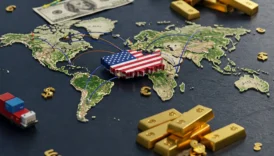How Banks Create Money from Nothing and Put You in Debt
It’s claimed that the modern monetary system is an illusion. Money is created through debt, and banks conjure it out of thin air. But is this system sustainable? Here’s the inside story of the economic machine.
- How Banks Create Money from Nothing and Put You in Debt
- Is It Life or Invisible Servitude? Questioning the System
- From Barter to Precious Metals: The Evolution of Money
- From Goldsmith Certificates to Banknotes: The Birth of Representative Money
- The Gold Standard: Days When Money Had Tangible Backing
- The 1971 Nixon Shock: The End of the Gold Standard and the Era of Fiat Money
- Unlimited Money Printing: But Where is the Value?
- Modern Money Creation: Government Debt and Central Banks
- The Anatomy of Inflation: Why Does Our Purchasing Power Keep Decreasing?
- The Banks' Secret: Fractional Reserve System and Creating Money Out of Thin Air
- The Debt Cycle: Why Are We Constantly Encouraged to Borrow?
- The Psychology of Spending: Why Does Paying with Cash Hurt More?
- The Danger of a Cashless Society and the Movie "In Time"
- Final Thoughts
Is It Life or Invisible Servitude? Questioning the System
Wake up every morning, go to work, earn money, pay the bills, take a short breath, then repeat… For most of us, this sums up life. But is this truly living, or is it an invisible system of servitude we find ourselves in without realizing it? What if I told you that this economic system we live in, money itself, is largely an illusion? Once you understand how money is produced and how banks operate, perhaps nothing will ever be the same. If we truly knew the rules of the system, would we continue living this way?
From Barter to Precious Metals: The Evolution of Money
Money has been the cornerstone of trade throughout human history. However, the origins of the paper notes in our pockets or the digital numbers on our screens lie in much more tangible foundations. Thousands of years ago, people conducted trade through direct barter. A farmer would exchange his wheat for pottery from an artisan. But this system had its difficulties: matching values, divisibility of goods, difficulty of transport, etc. A potter needed to have the exact number and value of pots desired by the grain owner to get the grain needed – this wasn’t always possible.
To overcome these challenges, societies eventually found a more practical solution: precious metals like gold and silver. Why? Because these metals were rare, durable, easily divisible, portable, and universally accepted as valuable. Thus, gold and silver coins became universal mediums of exchange, greatly facilitating trade.
From Goldsmith Certificates to Banknotes: The Birth of Representative Money
However, as trade volumes increased and people accumulated larger amounts of wealth, carrying gold and silver constantly became both cumbersome and risky. This is where goldsmiths, arguably the first bankers in history, came into play. People began entrusting their precious metals to the secure vaults of trusted goldsmiths. In return, they received written certificates from the goldsmith, indicating they could reclaim their deposited gold whenever they wished.
Over time, people realized that trading directly with these certificates was much easier than going to the goldsmith each time to withdraw physical gold. Everyone knew that the certificate was backed by real gold in the goldsmith’s vault and trusted it. Goldsmiths, on the other hand, noticed something else: people were trading with the certificates, but very rarely withdrew their physical gold. The gold in the vaults largely remained untouched.
This situation gave some “clever” goldsmiths an attractive idea: issue more certificates than the actual amount of gold in their vaults and lend these out (for interest). After all, not everyone would come to withdraw their gold at the same time. This was the first step towards modern banking and the “fractional reserve” system. Representative money, exceeding the physical backing in the vaults, entered circulation. These certificates eventually evolved into official “banknotes.”
The Gold Standard: Days When Money Had Tangible Backing
For centuries, many countries operated under a “gold standard” or similar precious metal standards. In this system, governments or central banks could only issue banknotes equivalent to the gold or silver reserves they held. Every paper note issued theoretically had a tangible gold backing in the vault, and any citizen could exchange their money for gold. This system played a crucial role in maintaining the value of money because there was a physical constraint on arbitrary money printing by governments. Money was still based on a tangible value (gold).
The 1971 Nixon Shock: The End of the Gold Standard and the Era of Fiat Money
However, the major wars of the 20th century (especially WWI and WWII), economic crises (like the 1929 Great Depression), and the ever-increasing spending needs of states led them to view the gold standard as an obstacle. Governments needing more money to finance wars, stimulate the economy, or support social programs did not want to be constrained by their gold reserves.
The turning point came on August 15, 1971. Then-US President Richard Nixon, under pressure from the rising costs of the Vietnam War and demands from other countries to redeem their dollars for US gold reserves, unilaterally announced the suspension of the US dollar’s direct convertibility to gold. This decision effectively marked the end of the Bretton Woods system and, consequently, the global gold standard.
From this date onwards, the world transitioned to a “fiat money” system. Fiat money is currency not backed by any physical commodity like gold or silver; its value derives entirely from the authority of the issuing government, legal requirement, and the public’s trust in it. Governments and central banks now had the power, theoretically, to print “unlimited” amounts of money without being tied to gold reserves.
Unlimited Money Printing: But Where is the Value?
The biggest question arising from the abandonment of the gold standard was: If money can be printed limitlessly by the decision of an authority, without any tangible backing, what is its real value? While this new system provided great flexibility to governments and central banks, it also brought the inherent risk of continuous erosion of the currency’s value.
History is replete with the bitter consequences of uncontrolled money printing. Two striking recent examples:
- Zimbabwe: In the 2000s, the government printed money incessantly to cope with a deepening economic crisis. The result was hyperinflation. Inflation reached such horrific levels that people had to carry sacks of cash just to buy a loaf of bread. Eventually, the Zimbabwean dollar became completely worthless, and the public started using foreign currencies like the US dollar.
- Venezuela: A similar scenario unfolded in the 2010s. The government kept printing money to cover budget deficits. In 2018, the annual inflation rate was expressed in millions. Prices in supermarkets changed within days, even hours, and people struggled to access basic foodstuffs. A large portion of the population had to resort to using US dollars or cryptocurrencies.
These examples highlight the greatest risk of the fiat money system: uncontrolled money printing leads to the rapid devaluation of currency, the destruction of people’s purchasing power and savings, and complete economic chaos. Are today’s major economies immune to this risk? Not quite. Especially after the 2008 global financial crisis and the 2020 Covid-19 pandemic, the US Federal Reserve (FED), the European Central Bank (ECB), and other major central banks injected trillions of dollars and euros into the markets to “stimulate” economies. While these “quantitative easing” policies seemed to provide short-term relief, they became one of the primary drivers of high inflation in the long run.
Modern Money Creation: Government Debt and Central Banks
Most people think governments meet their need for money only by collecting taxes or directly printing banknotes. However, the main mechanism of money creation in the modern economy works very differently: Debt.
Government expenditures (defense, education, health, infrastructure, etc.) often exceed tax revenues. To cover this budget deficit, governments borrow money. But this isn’t like us taking out a loan from a bank. Governments issue debt securities called “bonds” or “treasuries.” These securities are an offer from the government to investors (individuals, companies, pension funds, banks, and even other countries): “Lend me money today against this security, and I will pay you back the principal plus interest after a certain period.”
Here’s where the critical point comes in: If the country’s Central Bank buys these government bonds, the Central Bank technically creates new money out of thin air to pay for them and gives this money to the government. So, the government borrows, the Central Bank creates new money by buying this debt, and transfers it to the government. This newly created money enters the economy through government spending. The system keeps running this way. But there’s a cost: the government must repay its debts with interest. To pay the interest, it often has to borrow even more. This creates a perpetual cycle of borrowing and money printing.
The Anatomy of Inflation: Why Does Our Purchasing Power Keep Decreasing?
The inevitable consequence of this continuous cycle of borrowing and money creation is inflation. What happens when new money is constantly pumped into the market, but the amount of goods and services in the economy doesn’t increase at the same rate? More money starts chasing the same amount of goods. This leads to a rise in the general price level, i.e., inflation. Inflation means a decrease in the purchasing power of money. This is the fundamental reason why an item you bought for 10 lira last year might cost you 15 lira the next year. Even if the amount of money in your pocket stays the same, the things you can buy with it decrease. This acts like a hidden tax, especially for fixed-income earners whose salaries don’t keep up with inflation and for those who keep their savings in cash.
The Banks’ Secret: Fractional Reserve System and Creating Money Out of Thin Air
The money creation mechanism isn’t limited to governments and central banks. The commercial banks we use daily also possess the power to create money seemingly out of thin air, thanks to the “fractional reserve banking” system.
Most people think banks simply collect deposits and lend out that same money. That is, if a bank has 100 TL in its vault, it can lend out at most 100 TL. But the reality is quite different.
The modern banking system requires banks to keep only a small fraction (e.g., 10%, this ratio varies by country and regulation) of the deposits they collect as reserves in their vaults or at the central bank. They can lend out the rest.
Let’s illustrate with an example:
- Ahmet deposits 100 TL into the bank.
- The bank keeps 10 TL (10%) as a reserve.
- It lends the remaining 90 TL to Mehmet.
- Mehmet spends this 90 TL, and the money is deposited into someone else’s (say, Ayşe’s) bank account.
- Ayşe’s bank keeps 9 TL (10% of 90 TL) as a reserve and lends the remaining 81 TL to Fatma.
- This cycle continues…
What happens in the end? Ahmet still sees 100 TL in his bank account. Mehmet has a debt, but a purchasing power of 90 TL has been created (which moves to someone else’s account when spent). Ayşe sees 90 TL in her account (but her bank has lent 81 TL of it to someone else)… By repeating this process multiple times, the initial 100 TL deposit can theoretically create up to 1000 TL of new “book money” (money existing in bank records) circulating within the system.
So, a vast majority of the money in the market isn’t actually physically printed banknotes but rather debt created “out of thin air” by banks through the lending process. The most interesting and simultaneously fragile aspect of this system is this: If everyone who deposited money in the bank decided to withdraw their cash simultaneously (a bank run), the bank couldn’t meet the demand. Because the actual reserves held by the bank are only a tiny fraction of the total book money it has created. The system relies on the confidence that most people won’t withdraw their money all at once.
The Debt Cycle: Why Are We Constantly Encouraged to Borrow?
For this system to continue, money needs to be constantly circulating, and most importantly, new debt needs to be created. Because the money created is debt, and it must be repaid with interest. More debt is taken on to pay the interest. If people and companies stop borrowing, the inflow of new money into the system stops, existing debts become unpayable, and the economy grinds to a halt.
Therefore, the system constantly encourages borrowing:
- Mortgages to buy homes
- Car loans to buy vehicles
- Credit cards and consumer loans for daily expenses
- Business loans to start or expand businesses…
Advertisements, campaigns, low interest rates (periodically) all serve to keep this appetite for borrowing alive. Thus, people and companies spend, invest, and keep the economy turning with money created by banks from scratch. However, when it comes to repayment, they have to pay back this money, plus interest, with the fruits of their real labor.
The Psychology of Spending: Why Does Paying with Cash Hurt More?
Another way the modern economic system nudges people towards spending more is by changing payment habits. The use of cash is steadily declining, while credit cards, debit cards, and digital payment systems are becoming widespread. This isn’t just for practical reasons; it also has profound psychological effects.
Research shows that people are more careful and resistant to spending when paying with cash. The physical act of handing over money creates a sense of loss in the brain, which makes spending harder. However, when using a credit card or digital payment, this physical connection is severed. The moment of payment becomes more abstract and less painful. The result? People tend to spend more, and often more thoughtlessly, when paying by card or digitally.
- The MIT Experiment: An experiment conducted at MIT in 2000 clearly demonstrated this difference. One group of participants was given the option to pay only with cash, while another group could pay with a credit card. The results showed that the credit card group spent, on average, 83% more than the cash group.
- Casino Chips: The use of colorful chips instead of real money in casinos relies on the same psychology. People lose awareness that they are playing with real money, take risks more easily, and spend more.
- PayPal and Digital Payments: The success of digital payment systems like PayPal also lies in this psychology. Making payments easier and more abstract increases consumption. Investors who saw this potential bought PayPal for billions of dollars, and this model paved the way for countless digital payment platforms promoting the idea of a “cashless society.”
The Danger of a Cashless Society and the Movie “In Time”
The scenario of a “cashless society,” where cash gradually disappears and all financial transactions become digital, brings with it significant questions and potential dangers. In a system where all our spending is recorded and our financial movements can be tracked instantly, how secure will our individual freedoms and privacy be? Will control over the financial system fall entirely into the hands of central authorities and technology companies?
One of the most striking fictional examples illustrating the potential dangers of this system is the 2011 movie “In Time.” In the film, “time” is used as currency. People live with digital counters integrated into their arms; they earn time by working and lose time by spending. While the rich can live for hundreds, thousands of years, the poor literally have to count every second to survive. When their time runs out, their lives end too. The film offers a dystopian perspective, questioning how money (or time) can be abstracted and turned into a control mechanism, how it can deepen inequalities, and how the system might actually be broken.
Considering that the money we use today is already largely an abstract debt created in bank records, the question of who will be in control in a fully digitized system becomes even more critical.
Final Thoughts
All of us, whether we are aware of it or not, are part of a complex and ever-expanding debt cycle. Is the job we go to every morning truly a life we chose, or is it a necessity we endure just to pay off the debts imposed on us by the system? Perhaps the most fundamental question we need to ask ourselves is this: Do we control money, or does money control us? And if money controls us, who or what controls it? The answers to these questions perhaps hold one of the biggest secrets of the modern world.
Bibliography
- Ferguson, Niall. The Ascent of Money: A Financial History of the World. Penguin Books, 2008.
- Galbraith, John Kenneth. Money: Whence It Came, Where It Went. Houghton Mifflin, 1975.
- Harari, Yuval Noah. Sapiens: A Brief History of Humankind. Harper, 2015. (Especially chapters on the evolution of money and trust.)
- Rothbard, Murray N. What Has Government Done to Our Money? Ludwig von Mises Institute, 1963. (Offers a critical perspective on the gold standard and fiat money systems.)
- Ariely, Dan. Predictably Irrational: The Hidden Forces That Shape Our Decisions. Harper Perennial, 2008. (On the psychology of spending and behavioral economics.)
- Weatherford, Jack. The History of Money. Crown Publishers, 1997.





